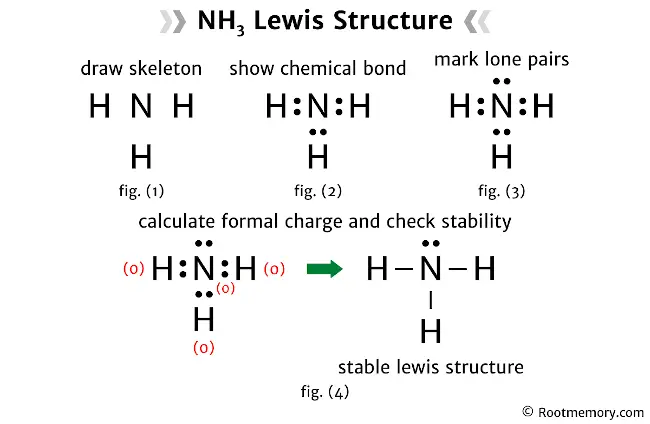
The Lewis structure of NH3 depicts the arrangement of valence electrons and the chemical bonds in ammonia, a compound with one nitrogen atom and three hydrogen atoms.[1][2][3][4] In this structure, the nitrogen atom is the central atom and is bonded to the three hydrogen atoms through single bonds. The nitrogen atom has one lone pair of electrons, while none of the hydrogen atoms possess lone pairs.[5][6][7] The nitrogen atom satisfies the octet rule, while each hydrogen atom adheres to the duet rule. The final structure of NH3 has no formal charges, indicating that it is stable.[8][9][10][11]
The initial step in drawing this Lewis structure is to calculate the total number of valence electrons and determine the central atom by choosing the least electronegative element among all the atoms in the molecule.[12][13][14][15] Once you have this information and have identified the central atom, create a rough outline of the structure. In the second step, use two electrons (represented as dots) to indicate the chemical bonds between each pair of atoms in the sketch. In the third step, decide how many lone pairs each atom should receive. Begin by marking lone pairs on the outer atoms, and then on the central atom. In the fourth step, check whether each atom satisfies the octet rule or the duet rule (for hydrogen). If an atom does not achieve an octet, redistribute the lone pairs as necessary. In the final step, calculate the formal charge for each atom, mark it on the sketch, and assess whether the final structure is stable.
Alternative method: NH3 Lewis structure
Steps
Draw skeleton
In this step, first calculate the total number of valence electrons. And then, decide the central atom.
- Let’s calculate the total number of valence electrons
We know that… nitrogen is a group 15 element and hydrogen is a group 1 element. Hence, nitrogen has five valence electrons and hydrogen has one valence electron.
Now NH3 has one nitrogen atom and three hydrogen atoms.
So the total number of valence electrons = valence electrons of nitrogen atom + (valence electrons of hydrogen atom × 3)
Therefore, the total number of valence electrons = 5 + 3 = 8
- Now decide the central atom
We can not assume hydrogen as the central atom, because the central atom is bonded with at least two other atoms. And hydrogen has only one electron in its last shell, so it can not make more than one bond.
Hence, assume that nitrogen is the central atom.
So now, put nitrogen in the center and hydrogens on either side. And draw the rough skeleton structure for the Lewis structure of NH3 something like this:

Also read: How to draw Lewis structure of HCN (5 steps)
Show chemical bond
Place two electrons between the atoms to show a chemical bond. Since nitrogen is surrounded by three hydrogens, use six electrons to show three chemical bonds as follows:

Also read: How to draw Lewis structure of SO2 (6 steps)
Mark lone pairs
As calculated earlier, we have a total of 8 valence electrons. And in the above structure, we have already used six valence electrons. Hence, two valence electrons are remaining.
And two valence electrons represent one lone pair.
Note that nitrogen is a period 2 element, so it can not keep more than 8 electrons in its last shell. And hydrogen is a period 1 element, so it can not keep more than 2 electrons in its last shell.
Also, make sure that you start marking these lone pairs on outside atoms first. And then, on the central atom.
The outside atoms are hydrogens. But hydrogen can not keep more than 2 electrons in its last shell. Hence, don’t mark the lone pairs on hydrogen.
So the central atom (nitrogen) will get one lone pair.
Now draw the Lewis structure of NH3 something like this:

In the above structure, you can see that the octet is completed on the central atom (nitrogen), and also on the outside atoms. Therefore, the octet rule is satisfied.
After completing the octet, one last thing we need to do is, calculate the formal charge and check the stability of the above structure.
Also read: How to draw Lewis structure of N2 (5 steps)
Calculate formal charge and check stability
The following formula is used to calculate the formal charges on atoms:
Formal charge = valence electrons – nonbonding electrons – ½ bonding electrons
Collect the data from the above structure and then, write it down below as follows:
- For nitrogen atom
Valence electrons = 5
Nonbonding electrons = 2
Bonding electrons = 6
Formal charge = 5 – 2 – ½ (6) = 0
- For each hydrogen atom
Valence electrons = 1
Nonbonding electrons = 0
Bonding electrons = 2
Formal charge = 1 – 0 – ½ (2) = 0
Mention the formal charges of atoms on the structure. So the Lewis structure of NH3 looks something like this:

In the above structure, you can see that the formal charges of both (nitrogen and hydrogen) are zero. Therefore, this is the stable Lewis structure of NH3.
And each horizontal line drawn in the above structure represents a pair of bonding valence electrons.
Next: Lewis structure of HCN
Related
- Lewis structure of HCN
- Lewis structure of SO2
- Lewis structure of N2
- Lewis structure of NO3–
- Lewis structure of CH4
References
Deep
Rootmemory.com was founded by Deep Rana, who is a mechanical engineer by profession and a blogger by passion. He has a good conceptual knowledge on different educational topics and he provides the same on this website. He loves to learn something new everyday and believes that the best utilization of free time is developing a new skill.
